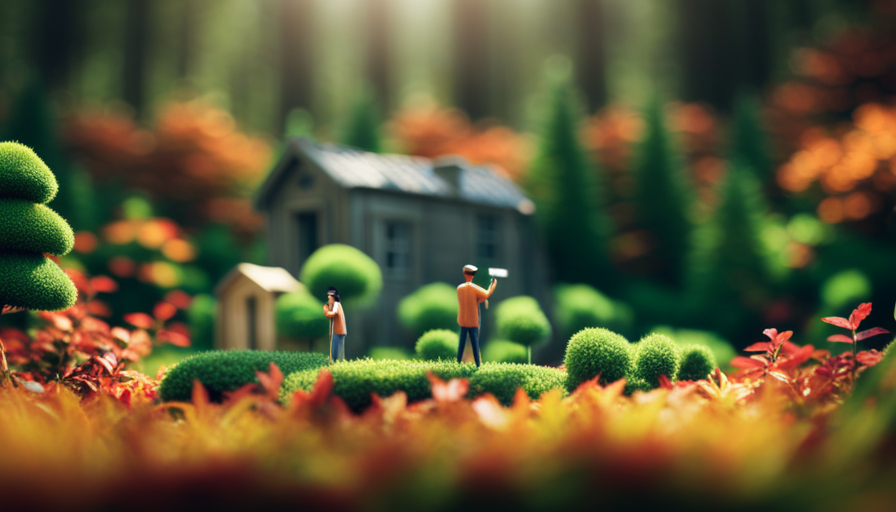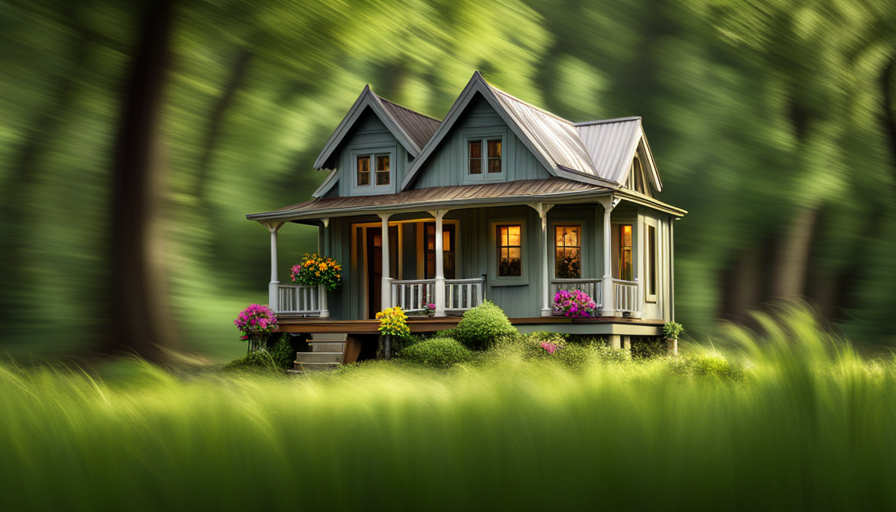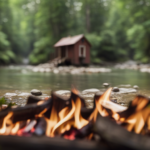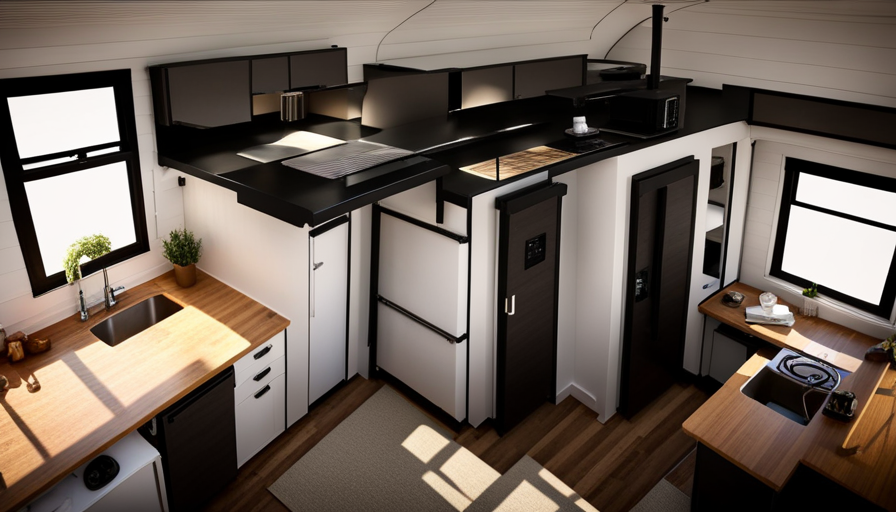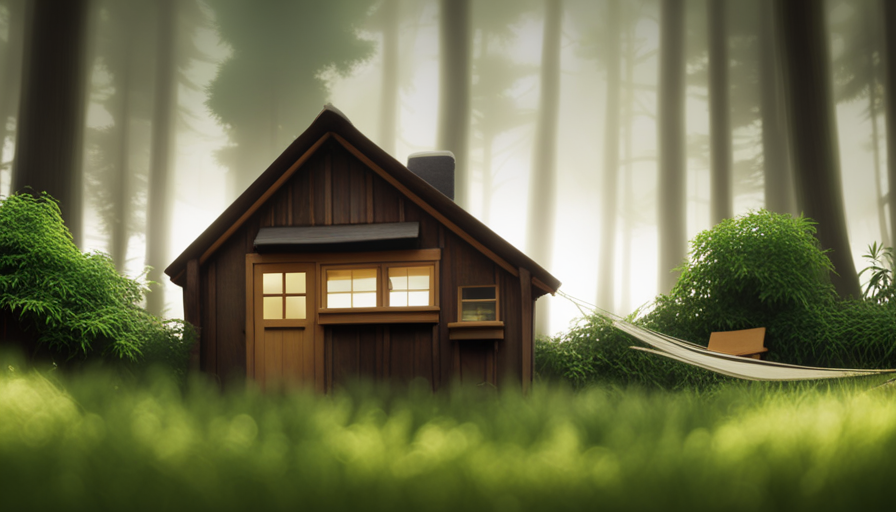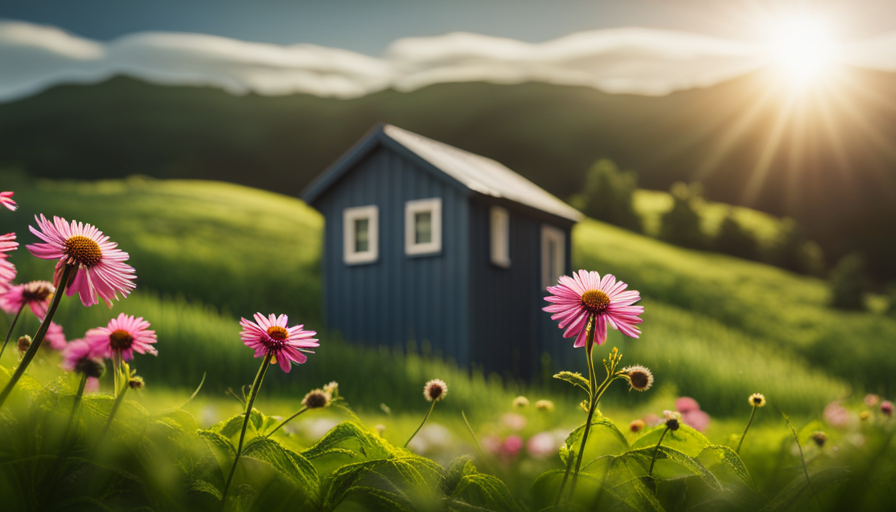Picture yourself exhausted from the never-ending hustle and bustle of city life, yearning for peace and freedom. You dream of a peaceful, charming sanctuary – a cozy abode nestled in nature, providing you with an escape from the stresses of modern life. But before embarking on this exciting journey, there’s one important question you must answer: how much does it cost to build a tiny home?
Fear not, fellow dreamer, for I have delved into the depths of research and planning to uncover the true cost of building your very own tiny house. In this article, we will explore the various factors that contribute to the cost, from the size and design to the materials and construction. We will also discuss the pros and cons of DIY versus hiring professionals, and explore financing options to make your dream a reality.
So grab a pen and paper, my friend, for we are about to embark on a detailed and analytical exploration of the costs involved in building a tiny house. Let’s dive in and uncover the secrets that lie within the world of tiny house construction.
Key Takeaways
- Size, design, materials, and construction all contribute to the cost of building a tiny house.
- Research, planning, and budgeting are crucial for finding the perfect location and builder.
- Using affordable and sustainable materials can help stay within budget while being eco-friendly.
- Proper estimation of expenses, including permits/fees and utilities, is important to understand the financial commitment.
Research and Planning
Researching and planning your tiny house project can be an exciting and empowering journey towards achieving your dream home on a budget. The first step is finding the perfect location for your tiny house. Consider factors such as zoning regulations, proximity to amenities, and the overall vibe of the neighborhood. You want to ensure that your tiny house fits seamlessly into its surroundings and provides you with the lifestyle you desire.
Once you have found the perfect location, the next step is to find the right builder. Look for experienced builders who specialize in tiny houses and have a portfolio of successful projects. Take the time to read reviews, visit their previous works, and ask for references. A skilled builder will be able to bring your vision to life while optimizing space and functionality.
Now that you have the location and the builder, it’s time to determine your budget. This involves carefully considering all the costs involved, including materials, labor, permits, and any additional features you want to include. Creating a detailed budget will help you stay on track and avoid any unexpected expenses.
Researching, planning, finding the perfect location, and finding the right builder are crucial steps in building a tiny house. These steps lay the foundation for a successful and cost-effective project, bringing you closer to achieving your dream of owning a tiny home without breaking the bank.
Determine Your Budget
Planning your budget for constructing a tiny home is like embarking on a thrilling adventure, where you shape your dreams into reality while carefully calculating every penny. Setting financial goals is a crucial step in this process. Determine how much you’re willing to invest in your tiny house project and establish a realistic budget. Consider your income, savings, and any potential loans or grants that may be available to you.
It’s important to have a clear understanding of your financial limitations and to stick to your budget throughout the construction process.
Once you have set your financial goals, the next step is to find affordable materials. Research and compare prices from different suppliers to ensure you’re getting the best deals. Look for discounts, promotions, or even consider purchasing used materials that are still in good condition. Additionally, consider alternative building materials that may be more cost-effective while still maintaining the quality and durability you desire.
By setting financial goals and finding affordable materials, you can ensure that your tiny house project stays within your budget. With careful planning and cost-conscious decision-making, you can create the tiny home of your dreams without breaking the bank.
In the next section, we’ll discuss how to choose the right size and design for your tiny house, taking into account both your budget and personal preferences.
Choose the Right Size and Design
When it comes to crafting your ideal tiny home, finding the perfect size and design is like uncovering a hidden treasure that reflects both your personal style and budgetary considerations. Choosing the right layout and designing for efficiency are key factors in creating a functional and comfortable living space.
In order to determine the right size for your tiny house, you need to consider your lifestyle and needs. Are you a minimalist who can thrive in a smaller space, or do you require more room for storage and activities? Additionally, the design of your tiny house should maximize the use of available space, with clever storage solutions and multi-purpose furniture.
To help you visualize the possibilities, here is a table that outlines some popular tiny house sizes and their approximate square footage:
| Size | Square Footage |
|---|---|
| Micro | 100-200 |
| Compact | 200-400 |
| Mid-size | 400-800 |
| Large | 800-1,000 |
| Extra Large | 1,000+ |
Considering your material options is the next step in the process of building your tiny house. By carefully selecting materials that are both cost-effective and durable, you can ensure that your investment will stand the test of time.
Consider Your Material Options
Choosing the right materials for your tiny home is essential to creating a durable and cost-effective living space that will withstand the test of time. When considering your material options, it’s important to look for affordable alternatives that won’t compromise the quality and longevity of your tiny house.
One such option is using reclaimed materials, which not only reduces costs but also adds character and uniqueness to your home. Additionally, sustainable choices such as bamboo flooring, recycled insulation, and low VOC paint can contribute to an eco-friendly and energy-efficient living environment.
Affordable alternatives like plywood or engineered wood can be used for the construction of walls and flooring, providing a sturdy and budget-friendly option. For insulation, recycled denim or cellulose insulation can be effective choices that provide both thermal and soundproofing benefits.
When it comes to roofing, metal or recycled rubber shingles are durable options that require minimal maintenance and have a longer lifespan compared to traditional materials.
By carefully considering your material options and exploring affordable and sustainable choices, you can strike a balance between cost and quality in building your tiny home. With these choices in mind, you can create a space that not only fits your budget but also reflects your commitment to sustainability.
Transitioning into the subsequent section about calculating the costs of construction, it’s important to analyze how these material choices will impact the overall budget of your tiny house.
Calculate the Costs of Construction
To accurately gauge the financial investment required for constructing your pint-sized dream abode, it is crucial to meticulously calculate the expenses associated with the entire construction process. Estimating expenses for building a tiny house involves considering various factors and pricing considerations. Here is a breakdown of the costs you need to consider:
-
Materials: The type and quality of materials you choose will significantly impact the overall cost. For example, using reclaimed or salvaged materials can help reduce expenses.
-
Labor: Whether you decide to hire professionals or tackle the construction process yourself, labor costs should be factored in. DIY builds can save money, but it requires time and expertise.
-
Permits and fees: Don’t forget to include the costs of obtaining necessary permits and paying fees required by your local government.
| Expense | Estimated Cost |
|---|---|
| Materials | Varies based on choices |
| Labor | Depends on DIY or hired help |
| Permits and fees | Varies by location |
By accurately estimating these expenses, you can get a better understanding of the financial commitment involved in building a tiny house. Once you have accounted for these costs, it’s important to factor in additional expenses, such as utilities and landscaping, which will be discussed in the subsequent section.
Factor in Additional Expenses
When calculating the costs of building a tiny house, it’s crucial to factor in additional expenses to ensure an accurate estimate. These hidden costs can easily add up and catch you off guard if not accounted for.
From my experience, I’ve learned that unexpected expenses can arise throughout the construction process. These expenses include permit fees, inspections, and utility connections. Individually, these costs may seem small, but they can quickly accumulate and significantly impact your budget.
To help you better understand the potential financial implications, here are three key items to consider:
-
Site preparation: Clearing the land, leveling the ground, and installing necessary utilities can be costly and often overlooked.
-
Customization and personal touches: Choosing high-end finishes or incorporating unique design elements can drive up the overall cost.
-
Transportation and delivery: Moving your tiny house to its final location can incur expenses, especially if you need to hire a professional transport service.
By considering these additional expenses, you can develop a more comprehensive budget and avoid any financial surprises.
Now that we have a clear understanding of the hidden costs and unexpected expenses, let’s delve into the next section: considering DIY vs. hiring professionals.
Consider DIY vs. Hiring Professionals
One important factor to consider is whether you’re capable of taking on the project yourself or if it’s better to hire professionals. Building a tiny house can be a challenging endeavor, especially if you have limited construction experience.
DIY challenges include the need for specialized knowledge in various areas such as carpentry, electrical, and plumbing. Without professional expertise, you may encounter difficulties in ensuring structural integrity, meeting building codes, and creating a functional and efficient living space. Additionally, time constraints and the potential for costly mistakes can further complicate the DIY process.
On the other hand, hiring professionals can provide numerous benefits. They possess the necessary skills and experience to handle all aspects of the construction process, ensuring a high-quality final product. They can efficiently navigate through the challenges that may arise and offer valuable insights and solutions. Furthermore, professionals are knowledgeable about building codes and can ensure that your tiny house meets all necessary regulations.
Considering the DIY challenges and the advantages of professional expertise, it may be worth exploring financing options for hiring professionals. By entrusting the project to skilled individuals, you can alleviate the stress and uncertainty associated with taking on the construction yourself.
Explore Financing Options
Exploring financing options allows me to visualize different pathways for funding my tiny house project. One option to consider is obtaining a tiny house loan. These loans are specifically designed for individuals looking to build or purchase a tiny house. They often have favorable terms and interest rates, making them a viable choice for financing.
Another option to explore is rent to own options. This allows me to rent a tiny house with the option to purchase it in the future. It can be a great way to test out the tiny house lifestyle before committing to buying one outright.
When considering financing options, it’s important to research and compare different lenders to ensure I’m getting the best possible terms. Some lenders may specialize in tiny house loans, while others may offer more general personal loans. Additionally, it’s important to have a clear understanding of my budget and financial capabilities before committing to any financing option.
Transitioning into the subsequent section about budgeting for utilities and maintenance, it’s crucial to also consider the ongoing costs associated with owning a tiny house.
Budget for Utilities and Maintenance
To truly embrace the freedom and simplicity of tiny house living, I must carefully plan and budget for the ongoing expenses of utilities and maintenance. One of the key considerations is budgeting for monthly bills.
While tiny houses are known for their energy efficiency, it’s important to account for the cost of electricity, water, and gas. By estimating my average monthly usage and researching the rates in my area, I can create a realistic budget for these utilities.
Additionally, I must not overlook the long-term maintenance costs. Although tiny houses require less maintenance compared to traditional homes, they still need regular upkeep to ensure their longevity. This includes tasks such as roof inspections, exterior painting, and appliance maintenance. By setting aside a portion of my budget for these expenses, I can avoid any unexpected financial burdens down the line.
In conclusion, budgeting for utilities and maintenance is crucial in order to fully enjoy the benefits of tiny house living. By carefully considering these ongoing expenses, I can create a sustainable and financially sound lifestyle. As I evaluate the long-term cost savings, I can explore ways to maximize efficiency and minimize expenses.
Evaluate Long-term Cost Savings
As I consider the potential savings over time, I can envision a future where my wallet feels lighter and my stress levels decrease. One of the key factors in evaluating long-term cost savings when building a tiny house is its energy efficiency. By incorporating energy-efficient appliances, insulation, and renewable energy sources, I can significantly reduce my monthly utility bills. This not only helps me save money but also minimizes my environmental impact.
To better understand the potential savings, I compared the rental costs of traditional houses with the estimated monthly expenses of a tiny house. The table below illustrates the comparison:
| Traditional House Rental | Tiny House Expenses | |
|---|---|---|
| Rent | $1,500 | $0 |
| Utilities | $300 | $100 |
| Maintenance | $200 | $50 |
| Total Monthly | $2,000 | $150 |
As shown in the table, the monthly expenses for a tiny house are significantly lower compared to renting a traditional house. With the absence of rent and substantially reduced utility and maintenance costs, the savings can quickly accumulate over time.
Considering these cost savings, building a tiny house becomes an attractive option for those looking to reduce their expenses and lead a more sustainable lifestyle. The initial investment in constructing a tiny house can pay off in the long run, providing not only financial benefits but also a sense of freedom and peace of mind.
Frequently Asked Questions
What are the legal requirements and permits needed to build a tiny house?
To build a tiny house, you’ll need to navigate through a maze of building codes and construction permits. It’s like trying to wrestle a mountain lion while juggling flaming torches – quite the adventure!
Can I build a tiny house on any type of land, or are there specific zoning regulations?
Zoning regulations and land restrictions determine where a tiny house can be built. It’s important to research local laws and permits before starting construction to ensure compliance with specific requirements and avoid potential legal issues.
Are there any restrictions on where I can park or place my tiny house?
Are there any parking regulations or land use restrictions for my tiny house? It’s crucial to research local ordinances and zoning laws to ensure compliance and avoid legal issues. Failure to do so can result in fines or having to relocate.
How do I choose the right location for my tiny house?
When choosing the perfect location for my tiny house, I consider several factors. These include proximity to amenities, access to utilities, zoning regulations, and the benefits of rural vs urban living.
What are the insurance requirements for a tiny house?
Insurance coverage for a tiny house typically includes liability and property coverage. Premiums depend on factors like the value of the house, location, and coverage limits. The cost of premiums can vary, but it’s essential to have adequate coverage to protect your investment.
Conclusion
In conclusion, building a tiny house requires careful research, planning, and budgeting. By considering factors such as size, design, materials, and construction costs, individuals can make informed decisions about whether to tackle the project themselves or hire professionals.
Exploring financing options and budgeting for utilities and maintenance are also crucial steps in the process. Ultimately, building a tiny house can be likened to assembling a puzzle, where each piece represents a cost or decision.
With meticulous attention to detail, the rewards of long-term cost savings and a sustainable lifestyle await those who embark on this unique endeavor.
Hi, I’m Emma. I’m the Editor in Chief of Tiny House 43, a blog all about tiny houses. While tree houses are often associated with childhood, they can be the perfect adult retreat. They offer a cozy space to relax and unwind, surrounded by nature. And since they’re typically built on stilts or raised platforms, they offer stunning views that traditional homes simply can’t match. If you’re looking for a unique and romantic getaway, a tree house tiny house might just be the perfect option.
